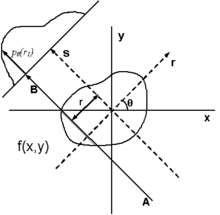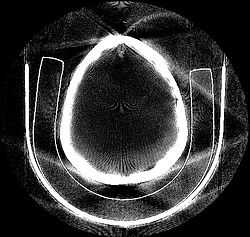Tomographic reconstruction
The mathematical basis for tomographic imaging was laid down by Johann Radon. It is applied in Computed Tomography to obtain cross-sectional images of patients. This article applies in general to tomographic reconstruction for all kinds of tomography, but some of the terms and physical descriptions refer directly to X-ray computed tomography.

The projection of an object at a given angle  is made up of a set of line integrals. In X-ray CT, the line integral represents the total attenuation of the beam of x-rays as it
travels in a straight line through the object. As mentioned above, the resulting image is a 2D (or 3D) model of the attenuation coefficient. That is, we wish to find the image
is made up of a set of line integrals. In X-ray CT, the line integral represents the total attenuation of the beam of x-rays as it
travels in a straight line through the object. As mentioned above, the resulting image is a 2D (or 3D) model of the attenuation coefficient. That is, we wish to find the image  . The simplest and easiest way to visualise the method of scanning is the system of parallel projection, as used in the first scanners. For this discussion we consider the data to be collected as a series of parallel rays, at position
. The simplest and easiest way to visualise the method of scanning is the system of parallel projection, as used in the first scanners. For this discussion we consider the data to be collected as a series of parallel rays, at position  , across a projection at angle
, across a projection at angle  . This is repeated for various angles. Attenuation occurs exponentially in tissue:
. This is repeated for various angles. Attenuation occurs exponentially in tissue:
where  is the attenuation coefficient at position
is the attenuation coefficient at position  along the ray path. Therefore generally the total attenuation
along the ray path. Therefore generally the total attenuation  of a ray at position
of a ray at position  , on the projection at angle
, on the projection at angle  , is given by the line integral:
, is given by the line integral:

Using the coordinate system of Figure 1, the value of  onto which the point
onto which the point  will be projected at angle
will be projected at angle  is given by:
is given by:
So the equation above can be rewritten as
where  represents
represents  . This function is known as the Radon transform (or sinogram) of the 2D object. The projection-slice theorem tells us that if we had an infinite number of one-dimensional projections of an object taken at an infinite number of angles, we could perfectly reconstruct the original object,
. This function is known as the Radon transform (or sinogram) of the 2D object. The projection-slice theorem tells us that if we had an infinite number of one-dimensional projections of an object taken at an infinite number of angles, we could perfectly reconstruct the original object,  . So to get
. So to get  back, from the above equation means finding the inverse Radon transform. It is possible to find an explicit formula for the inverse Radon transform. However, the inverse Radon transform proves to be extremely unstable with respect to noisy data. In practice, a stabilized and discretized version of the inverse Radon transform is used, known as the filtered back projection algorithm. Recent developments have seen the Radon transform and its inverse used for tasks related to realistic object insertion required for testing and evaluating Computed Tomography use in Airport Security.[1]
back, from the above equation means finding the inverse Radon transform. It is possible to find an explicit formula for the inverse Radon transform. However, the inverse Radon transform proves to be extremely unstable with respect to noisy data. In practice, a stabilized and discretized version of the inverse Radon transform is used, known as the filtered back projection algorithm. Recent developments have seen the Radon transform and its inverse used for tasks related to realistic object insertion required for testing and evaluating Computed Tomography use in Airport Security.[1]
References
- ↑ Megherbi, N., Breckon, T.P., Flitton, G.T., Mouton, A. (October 2013). "Radon Transform based Metal Artefacts Generation in 3D Threat Image Projection". Proc. SPIE Optics and Photonics for Counterterrorism, Crime Fighting and Defence 8901 (B). SPIE. pp. 1–7. doi:10.1117/12.2028506. Retrieved 5 November 2013.
Further reading
- Avinash Kak & Malcolm Slaney (1988), Principles of Computerized Tomographic Imaging, IEEE Press, ISBN 0-87942-198-3.
- Bruyant, P.P. "Analytic and iterative reconstruction algorithms in SPECT" Journal Of Nuclear Medicine 43(10):1343-1358, 2002
External links
- http://www.slaney.org/pct/
- http://www.itk.org/ Insight ToolKit; open source tomographic support software
- http://www.visielab.ua.ac.be/software ASTRA (All Scales Tomographic Reconstruction Antwerp) toolbox; very flexible, fast and open source software for computed tomographic reconstruction
- http://niftyrec.scienceontheweb.net/ NiftyRec; comprehensive open source tomographic reconstruction software; Matlab and Python scriptable



